Paper Computers
Tabletop games are “paper computers,” says Matthew Kirschenbaum (2009). Their histories are centuries old.
1. The Royal Game of Ur (2600BCE - 2400BCE). Made in present-day Iraq. Care of the Trustees of the British Museum. Used with permission. CC BY-NC-SA 4.0. They are designed. They enact systems of rules and procedures. And, most important, you don’t have to charge or program them.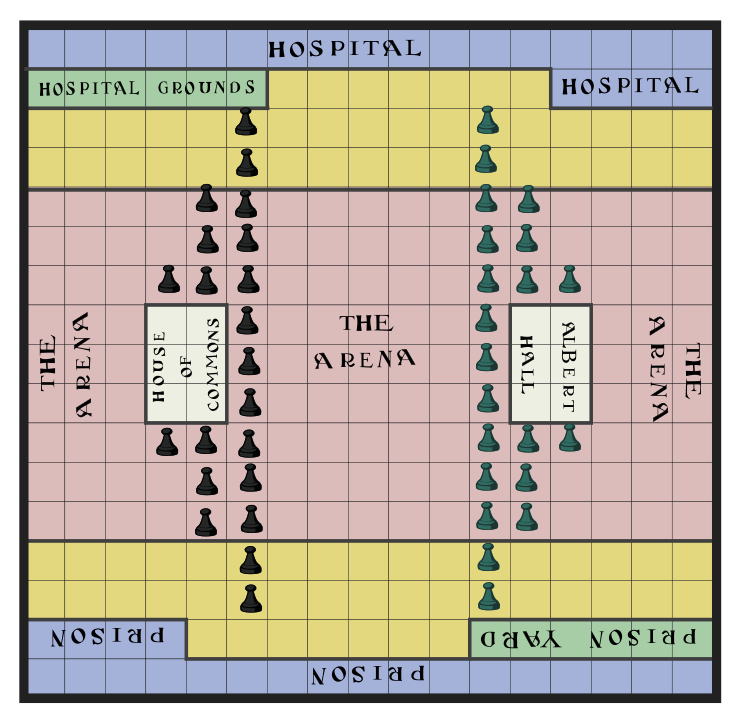
2. Suffragetto (1908), a board game where the Suffragettes aim to take the House of Commons while protecting Albert Hall. Image care of Wikipedia. CC BY-SA 4.0. Original at Bodleian Libraries, University of Oxford. Prototyped by Renee M. Shelby, Georgia Institute of Technology.
This seminar follows that low-tech disposition. We’ll survey the pasts of paper computers and their entanglements with literature. We’ll visit Special Collections to study some pertinent media, such as artists’ books, moveable books, machine-woven books, miniatures, cards, boards, and zines. Then you’ll select an “-ism” (e.g., imagism, constructivism, or thingism) and use it to prototype a tabletop game. We’ll discuss the dynamics that bridge aesthetics with mechanics, including how games rehearse legacies of colonialism and capital accumulation. What alternatives exist, and how are they made?
We’ll play some games as we go, and read a smidgen of fiction and history, too.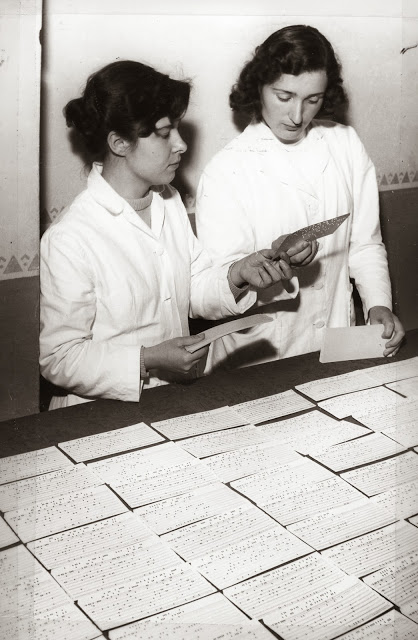
3. Livia Canestraro (left) and another researcher (right, name unknown) producing punchcards (late 1950s or early 1960s) of Thomas Aquinas’s work. Via Melissa Terras. Care of CIRCSE Research Centre and the Busa Archive, Università Cattolica del Sacro Cuore, Milan, Italy. Used with permission. CC-BY-NC. For more information, or to request permission for reuse, contact Marco Passarotti at marco.passarotti at unicatt.it or Largo Gemelli 1, 20123 Milan, Italy. From week to week, we’ll ground it all in design practices: bookbinding, 3D modelling, fabricating, and playtesting, for example.
4. Kriegspiel by Guy Debord. Fabricated in silver-plated copper (limited edition) in 1977. Mass-produced in cardboard and wood in 1987. Documentation and rules published in Le Jeu de la Guerre (1987) by Debord and Alice Becker-Ho. Photograph and historical context by Alexander Galloway via the Radical Software Group, who are reinterpreting Kriegspiel as a computer game. Used with permission. Various guest speakers will join us. By the end, you should develop a palpable sense of how this becomes that with a computer—but without running culture in the background.
Outline #
My name is Jentery Sayers, and I’m teaching this course. It’s a special topics seminar (English 508 and CSPT 500/600) at the University of Victoria (UVic) and the fourth in a series of prototyping courses I’ve designed. Here are the first three: 1, 2, and 3. This is the first one about tabletop gaming.
I’ve structured the outline for the seminar like so:
~ Acknowledgements: Territory and Support
~ Aims: Outcomes with Disclaimers
~ Materials: For Studying and Prototyping
~ Work: What to Do and When
~ Schedule: Week by Week, in Detail
~ Outline in PDF: Includes Policies
You can contact me at jentery@uvic.ca. I respond to emails within 24 hours, Monday-Friday, 9am-5pm, excluding holidays and conference travel. My office hours are Mondays, 10am-12pm, in CLE D334.
Acknowledgements #
As a faculty member who has the privilege to live and work as a guest on these lands, I acknowledge with respect the Lkwungen-speaking peoples on whose traditional territory the university stands and the Songhees, Esquimalt, and WSÁNEĆ peoples whose historical relationships with the land continue to this day.
Herb Blau, Kevin Brock, Yann Burrett, Jill Butler, Ed Chang, Amy Hildreth Chen,
5. Early modern printer’s mark or ‘device,’ which is also a card in Mark by Amy Hildreth Chen and Human(ities) Games. Used with permission. CC BY-NC 4.0. Rick Davidson, Mary Flanagan, Justin Foran, Lisa Gitelman, Bruce Hanington, Garnet Hertz, Kritina Holden, Patrick Jagoda, Dorothy Kim, Matthew Kirschenbaum, Carly Kocurek, Kari Kraus,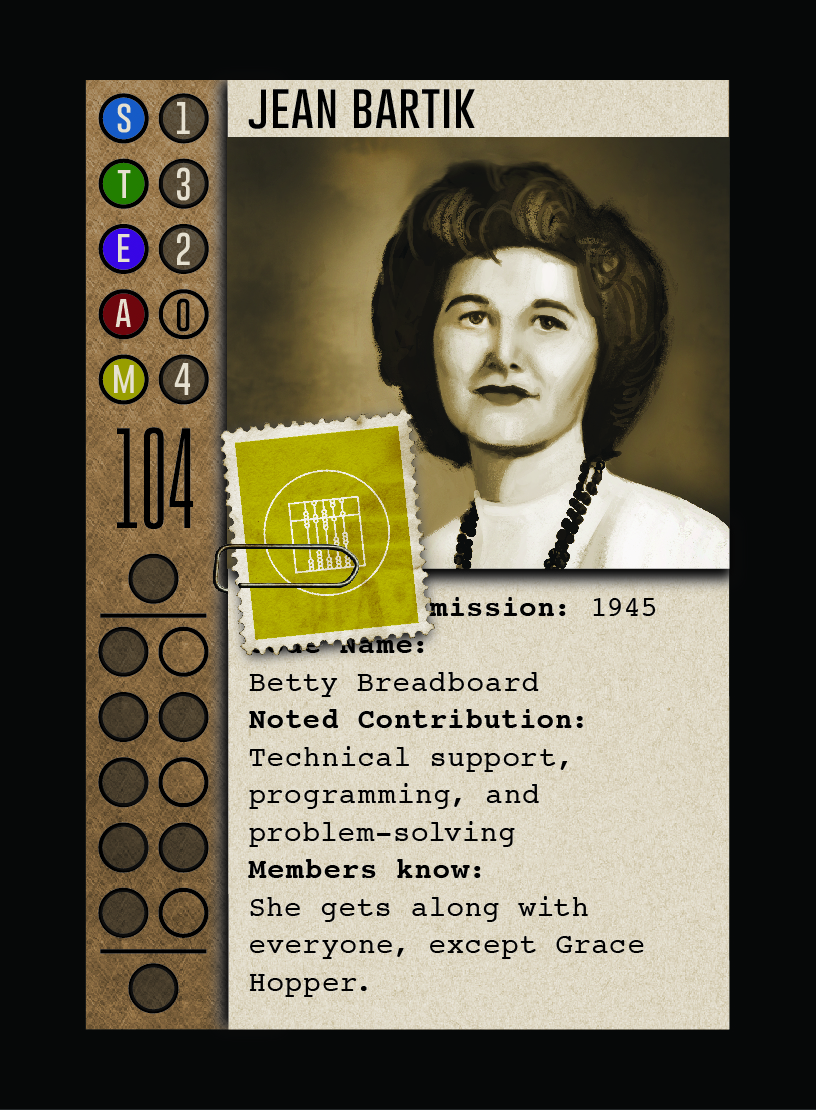
6. Jean Bartik card from The Tessera Inventors, a game by Kari Kraus, Derek Hansen, and the Tessera Team. Used with permission. Elizabeth LaPensée, William Lidwell, Hector Lopez, Bella Martin, Tara McPherson, Lisa Nakamura, Richard Pickard, Anastasia Salter, Alana Sayers, and Gillian Smith pointed me to materials that inform this seminar.
Special thanks to Bézier Games, Floodgate Games, Greater Than Games, Human(ities) Games, Rio Grande Games, and Hector Lopez for giving us games to study and play.
And tremendous thanks to Avery Alder, Nina Belojevic, Whitney “Strix” Beltrán, Anne Burdick, Emily Care Boss, Alexander Galloway, Amy Hildreth Chen, Isaac Childres, Derek Hansen, Matthew Kirschenbaum, Kari Kraus, Michael Lines, Shaun Macpherson, Renee M. Shelby, Nikki Valens, and Lara Wilson for agreeing to visit the seminar as guest speakers (via Skype or in person).
Aims #
By the end of this seminar, I’m hoping you will:
~ Examine the entanglements of game studies with literary and media studies through A-D-M and M-D-A frameworks (see Hunicke, LeBlanc, and Zubek) that foreground the dynamics (“D”) between aesthetics (“A”) and mechanics (“M”).
~ Understand paper computing as a centuries-old design practice and approach it through low-tech methods anchored in prototyping and playtesting.
~ Learn how speculation and prototyping apply to humanities project design and development, with particular attention to procedural literacy and material culture as well as paradigms of labour, conjecture, and negotiation.
~ Prototype an offline tabletop game (e.g., board game, card game, or tile game) informed by the politics and aesthetics of an “-ism” (between 1870 and 1970).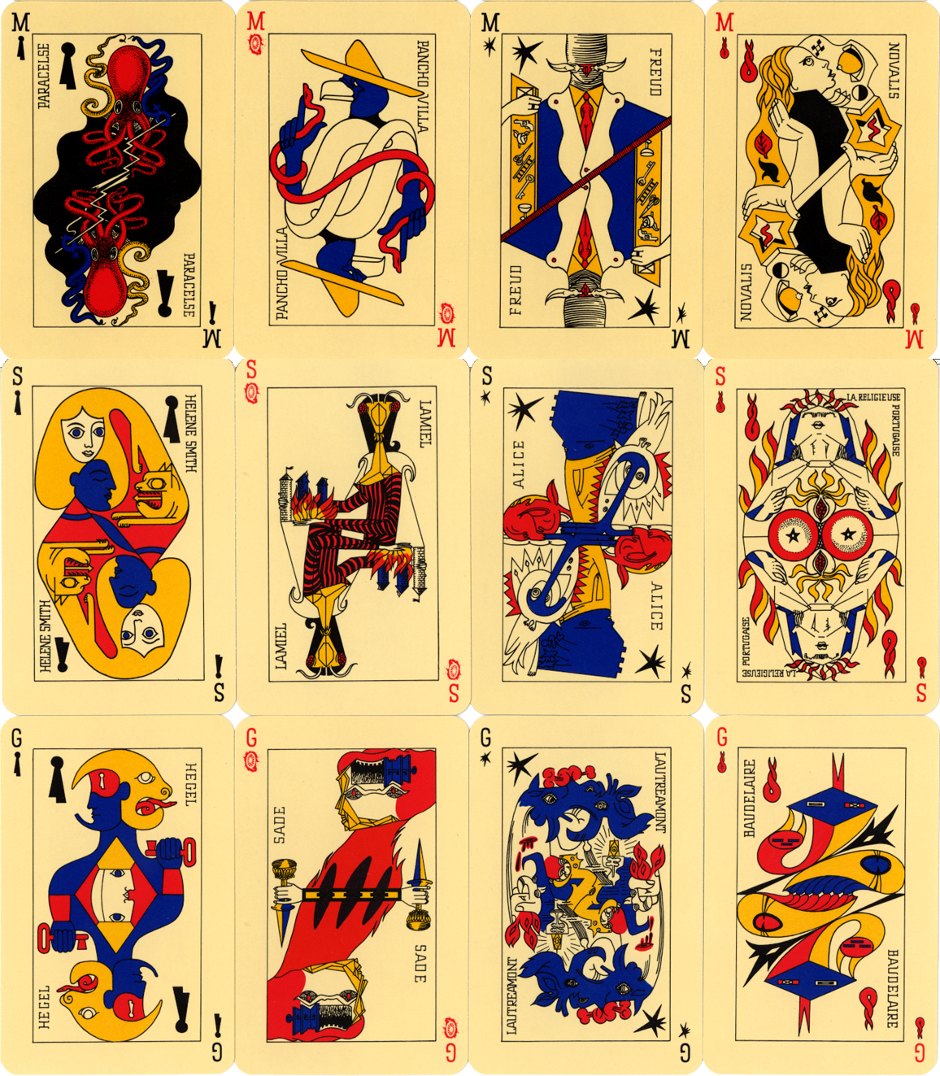
7. A Surrealist game. Cards from Le Jeu de Marseille published by Grimaud (Paris, 1983). The designs were first published in VVV Magazine (New York, 1943). Images courtesy of Barney Townshend. Used with permission.
~ Document your prototyping process through a combination of text and (moving) images.
~ Share and test your tabletop game with people in and beyond this seminar, while playing a few games, too.
~ Communicate (via a presentation and in writing) the relevance of your game prototype to literary and media studies.
Please note that this seminar does not require or involve any computer programming. It does not assume that you are a “gamer” or “geek,” care about being a gamer or geek, or have any experience with tabletop gaming, prototyping, or media studies. It is not a course intended to prepare you specifically for careers in the game or design industries (even if it will inevitably overlap with those industries). It is instead a course about using design methods to conjecture about the past and prompt meaningful interactions in the present.
Technical expertise required: know how to send an email.
Materials #
There is no textbook for this seminar, but I produced a passcode-protected course reader (in PDF) for you. See me for the ID and passcode. Links to individual readings are provided in the schedule. Beyond those, I recommend Tabletop Simulator (Berserk Games); Challenges for Game Designers, by Brenda Romero and Ian Schreiber; and A Deck of Lenses (app), by Jesse Schell. You’ll need access to a computer, and you might find a camera (or mobile phone) to be useful for documentation and prototyping.
I encourage you to compile (in groups or individually) your own “bit boxes” for prototyping.
8. Some components or ‘bits’ of the game, Gloomhaven, by Isaac Childres and Cephalofair Games (2017). Photo and tabletop mine. Depending on the sort of game you’re making, useful materials might include graph paper, cardboard, cutting mats, rotary cutters, rulers, printers, markers, pens, pencils, plasticine, scissors, rulers, cameras, tape, glue, dice, timers, and tokens. You may also need a few dollars to cover printing and fabricating costs.
Where possible, I will provide you with access to tabletop games.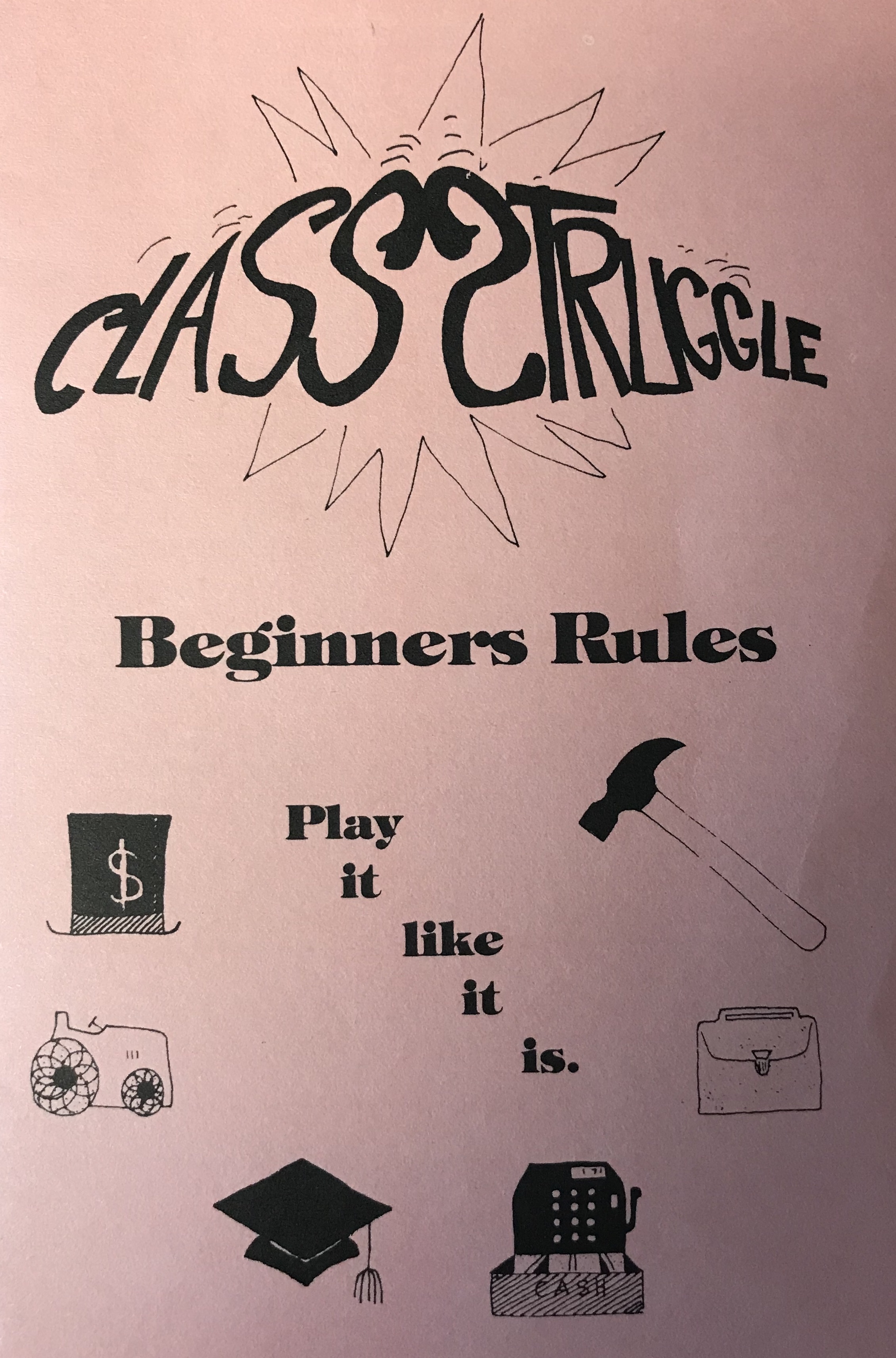
9. Manual for Class Struggle, by Bertell Ollman (NYU) and Class Struggle, Inc. (New York, 1978). Care of UVic English. Photo mine. I will also point you to local spots where you can play games for free or nearly free. Each week I will mention some games (and perhaps recommend one or two), but I won’t require you to play many in particular.
We may be able to use facilities on campus to design and fabricate components for your prototypes. These facilities contain 3D printers, routers, and laser cutters, but some of the equipment may only be used with permission or is subject to restricted use (because safety).
10. Laser-cut version of Elizabeth Magie’s The Landlord’s Game (US patent 748626A, 1904), the source material of what became Monopoly. Cut by Katherine Goertz in the MLab. Photo mine.
Work #
This seminar is project-based, meaning you’ll focus on the design and development of a prototype throughout the term (especially the second half), while also attending to matters of history, aesthetics, and culture. I’m asking you to cook up the following in the process:
~ Design Document (20% x 2): documentation of the iterative design and development of your game, including game components and drafts as well as responses to readings, games, playtests, and guest talks. You’ll submit the design doc twice (middle and end of term), and I’ll mark it each time.
~ Prototype (25%): not polished, but a playable, offline tabletop game complete with a manual and components (such as a board, tiles, and cards) enacting the game’s theme, mechanics, inventory, and rules while also asking “what if?” of literary and media history.
~ Talk + Paper (20%): a five- to seven-minute talk (delivered at the end of term) and revised into a final paper. It should address the relevance of your prototype to literary and media studies.
~ Participation (15%): such as preparing for seminar, bringing prototypes to meetings, contributing to discussions, and participating in workshops and playtests.
I’ll nudge you to avoid prototyping the following categories of games (during seminar I’ll explain why): trivia, quiz/word, old school revival, roll-and-move, tactical war, sequel, expansion, and educational. I can of course be convinced to rethink these biases. You may also decide to prototype a historical game (associated with a specific -ism) that either no longer exists or is difficult to access. For examples of this sort of work, see prototypes by Margaret Konkol and Renee M. Shelby.
Schedule #
Here’s the weekly schedule, which is subject to change. If I change it, then I’ll notify you at least one week in advance during seminar and/or via email.
I always over-plan. I will inevitably cut material, including workshops, readings, and exercises, especially when you and/or I feel like it’s just too much. Please note that guest speakers will contribute frequently to the seminar.Guest speakers this term: Avery Alder, Nina Belojevic, Whitney ‘Strix’ Beltrán, Anne Burdick, Emily Care Boss, Alexander Galloway, Amy Hildreth Chen, Isaac Childres, Derek Hansen, Matthew Kirschenbaum, Kari Kraus, Michael Lines, Shaun Macpherson, Renee M. Shelby, Nikki Valens, and Lara Wilson
Readings this term: work by Meguey Baker, Whitney ‘Strix’ Beltrán, Elizabeth W. Bruss, Anne Burdick, Rachel Sagner Buurma, Mary Ann Caws, Isaac Childres, Nicole Clouston, Samuel R. Delany, Johanna Drucker, Mary Flanagan, Alexander Galloway, Lisa Gitelman, Jessica Hammer, Katherine Hayles, Laura Heffernan, Margaret Konkol, Louise Krasniewicz, Kari Kraus, Matthew Kirschenbaum, Elizabeth LaPensée, Jerome McGann, Michelle Lorna Nahanee, Bethany Nowviskie, Janice Radway, Patrick Rael, Lisa Samuels, Susan Stewart, Melissa Terras, and some primary sources of your choice I will ask you to respond briefly (via your design doc) to our conversations with these speakers. Their names and affiliations are listed in the margins of this site (desktop view) or via plus buttons (mobile view), together with keywords and methods for each week. Please don’t worry if the keywords, methods, or names are unfamiliar to you. We’ll cover them during seminar and, more important, put them into conversation with the praxis of prototyping.
Also note that reading is front-loaded in this course. You’ll read more during the first half of term, and you’ll turn your attention to prototyping during the second half. Throughout the term, I hope you have multiple opportunities to play some games, too.Games this term: We’ll study Mark, Codex Conquest, Gloomhaven, The Tessera Inventors, The Quiet Year, and Mansions of Madness during seminar. You’ll also pick a few games to play on your own. Throughout the schedule, I’ve listed many (probably too many) games for your consideration. Search this page for ‘Optional’ to find them. These aren’t recommendations, tho. Mileage may vary. Drop a line with any questions or concerns. If you have questions, concerns, or doubts about any game I’ve listed here, then don’t hesitate to ask me for details before playing it. Finally, I link to many things here. Please don’t feel like you have to follow those links, let alone read what’s referenced. I provide the links for the purposes of attribution and scholarly responsibility and also in case you wish to pursue particular topics down the line.
~ Week 1 (Sept. 11): Why Paper Computers?
~ Week 2 (Sept. 18): Histories of Paper Computers
~ Week 3 (Sept. 25): Pick an -Ism and a Text.
~ Week 4 (Oct. 2): Play Some Games.
~ Week 5 (Oct. 9): Change a Game.
~ Week 6 (Oct. 16): Make Your Text a Concept Doc.
~ Week 7 (Oct. 23): Make It a Theme or Mechanic.
~ Week 8 (Oct. 30): Make It a Mechanic or Theme.
~ Week 9 (Nov. 6): Make It an Inventory.
~ Week 10 (Nov. 13): Take a Break from It.
~ Week 11 (Nov. 20): Fabricate It.
~ Week 12 (Nov. 27): Make It a Manual.
~ Week 13 (Dec. 4): Refine and Package It.
~ Week 14 (Dec. 11): Share It.
Week 1 (Sept. 11): Why Paper Computers? #
“Paper computing” and “speculative design” are not exactly common terms in English departments. This week we’ll spend some time defining and contextualizing them, considering their relevance to literary and media studies, and discussing how they will “unfold” in this seminar. (Sorry. I can’t resist puns.) I’ll also help you to plan ahead for the term.Keywords and methods for Week 1: A-D-M, aleatory procedures, conjectural criticism, design as inquiry, forensic imagination, game states, M-D-A, near futures, participatory or generative research, prediction, restoration, scenario or experience prototyping, simulation exercises, speculative design, speculative fiction, subjunctive knowledge, Wizard of Oz
Guest speakers for Week 1: Nina Belojevic and Shaun Macpherson (both UVic English grads) on prototyping as academic and industry work
Prior to seminar, please:
~ Review this website and write down questions or concerns you have about the seminar.
~ Read Kari Kraus, “Finding Faultlines: An Approach to Speculative Design,” including the “Family of Subjunctive Practices” (2018).
~ Optional: play Codenames (party, memory, partnership, 2-8 players), Coup (party, deduction, take-that, elimination, 2-6 players), Funemployed (party, humor, role-playing, storytelling, 3-20 players), Love Letter (renaissance, deduction, hand management, elimination, 2-4 players), Machi Koro (city building, card drafting, 2-4 players), Monikers (party, drafting, role-playing, 4-20 players), One Night Ultimate Werewolf (party, role-playing, variable player powers, voting, 3-10 players), The Resistance (bluffing, spies, simultaneous action selection, partnerships, 5-10 players), or Skull (party, bidding, bluffing, elimination, 3-6 players).
During seminar, we will:
~ Introduce ourselves, discuss motivations for the course, and review the course outline, including what prototyping will entail and how to compose a design doc in a text editor with Markdown (1 hour).Markdown: I composed this site in Markdown. For more about writing with it, see Sarah Simpkin, ‘Getting Started with Markdown,’ The Programming Historian 4 (2015).
~ Talk about paper computing, tabletop gaming, and speculative design as academic and industry practices (1 hour).
~ Paper-prototype a “game state” for a game about grad school (1 hour). Please log this work in your design doc.
~ Submit exit cards (you will leave questions and concerns for me).
Paper computing (see Kirschenbaum) and paper prototyping are relevant to present-day project design and development because they provide us with a sense of history while bypassing widespread tendencies to focus on whiz-bang technologies, which may demand significant resources that are not exactly accessible.Some ways to prototype historical texts: imitation (labour of the text), forgery (economy of the text), scenario (interaction through the text), story (performance of the text), counterfactual (norms of the text), model (logic of the text), glitch (negotiations with the text), and wish (ideology of the text). I’ll elaborate during seminar. They are conducive to various humanities methods (e.g., remediation and versioning), too, and they stress how people interact with materials. Speculative design (see Dunne and Raby and Lukens and DiSalvo) is useful since it puts design first, rather than treating it as the last step (“polishing” or “finishing”) of a project. It also privileges conjecture over proof while corresponding meaningfully with studies of speculative fiction, science fiction, fantasy, and futurisms, such as Afrofuturisms (see Nelson), Indigenous Futurisms (see Dillon), and near futures (see Bleecker et al.). In this seminar, we’ll combine paper computing with speculative design to ask “what if?” of media and literary history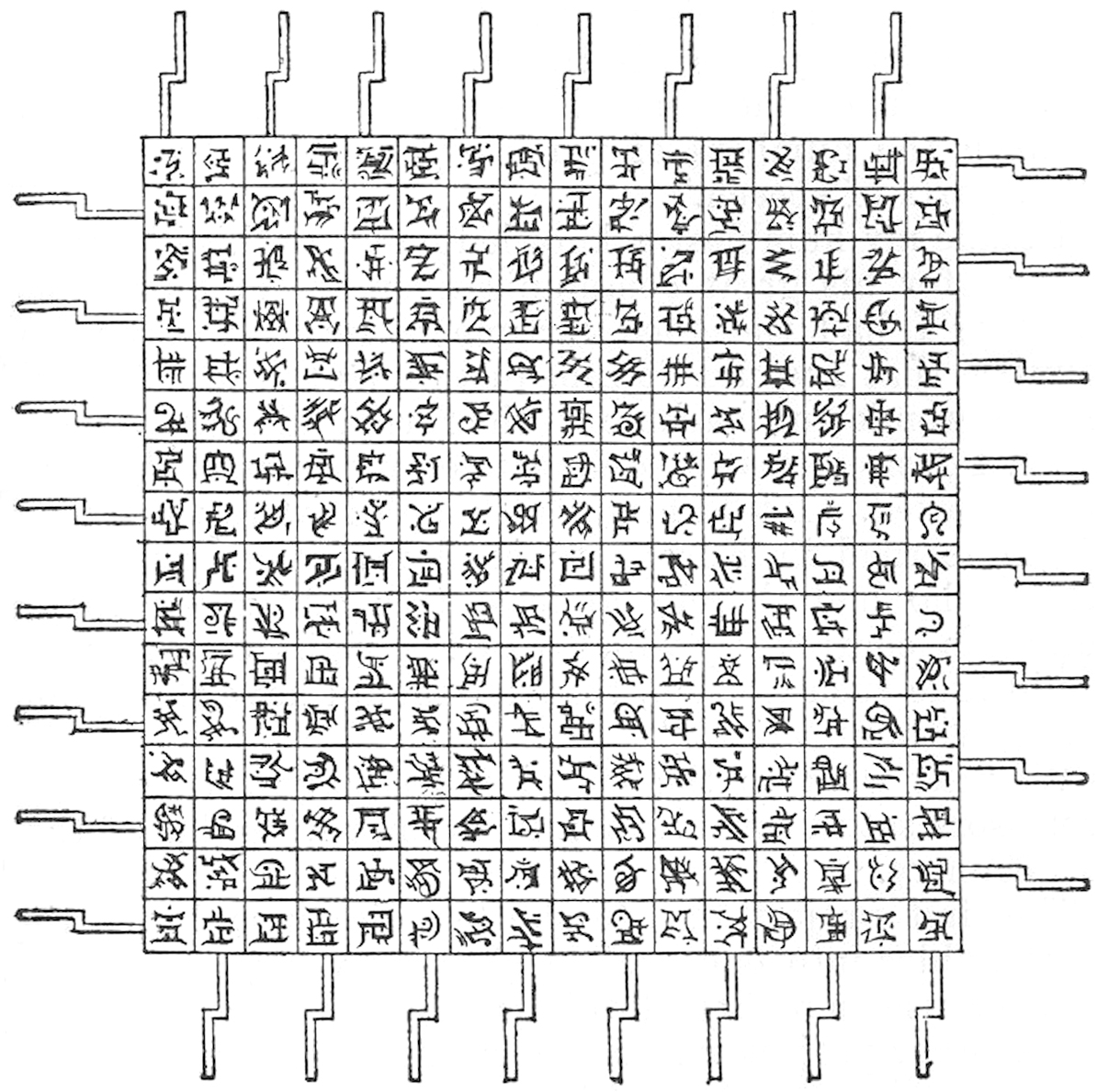
11. Jonathan Swift’s ‘Literary Engine.’ Via Bethany Nowviskie. From Gulliver’s Travels (1726/1892), George Bell and Sons edition. Project Gutenberg. –to prototype a text from the past in the present moment, with contexts of use and negotiation in mind. Here, a prototype will not be an exact reproduction or re-presentation of an historical artifact; it will be an interpretation (see MLab). And design will not be something an object has or even affords; it will be a line and mode of inquiry (see Rosner).
Week 2 (Sept. 18): Histories of Paper Computers #
While histories of paper computing could focus mostly, if not entirely, on tabletop gaming, this week we’ll suspend game studies and attend to other media histories where paper and computing meet. How are marks on paper not just authored or read, but used? How does paper serve as a storage medium for computation? Or as a mechanism for compiling and re-membering this into that? Who has been called a computer, and what roles did paper play in their labour and occupations? Keywords and methods for Week 2: affect, algorithm, blanks, context of use, machines, memory, ontological theatre, media archaeology, procedural experimentation, storage
Guest speakers for Week 2: Amy Hildreth Chen (Special Collections Instruction Librarian, University of Iowa) on Human(ities) Games, and also Lara Wilson (Director of Special Collections and University Archivist at UVic; Chair, Canadian Council of Archives) on artists’ books, moveable books, machine-woven books, cards, and zines
Prior to seminar, please:
~ Read Melissa Terras, “Father Busa’s Female Punch Card Operatives” (2013); Rachel Sagner Buurma and Laura Heffernan, “Search and Replace: Josephine Miles and the Origins of Distant Reading” (2018); and Lisa Gitelman, “A Short History of ____” (from Paper Knowledge, 2014).
~ Play Mark or Codex Conquest (to prepare for our conversation with Amy Hildreth Chen); you might also check out Robin David O’Keeffe’s Movable Type (card-drafting, print-and-play, 1-6 players).
~ Describe (~250 words plus images) in your design doc the game category, family, theme, state, view, space, mechanic(s), rules, components, and dynamics of either Mark or Codex Conquest (no need to review or analyze the game; just describe it).Some definitions: Category is the type of game. Family is the genre. Theme is the subject matter. State is a metagame (all relevant info, including info that changes). View is info you can see. Space is the area of the game. A mechanic (or mechanism) is an action or function. Rules are guidelines or protocols for action. Components are tactile parts or bits. Dynamics are embodied patterns of play. (For more, see Romero and Schreiber, Chapter 2.)
~ Optional: watch these videos on manufacturing board games (Stephen Conway et al.), early modern papermaking (University of Iowa’s Center for the Book), and playing the Royal Game of Ur (The British Museum), and read this Omeka project about Human Computers at NASA (Duchess Harris, Margot Lee Shetterly, Lucy Short, and Ayaan Natala, Macalester College).
During seminar, we will:
~ Visit Special Collections to learn about artists’ books, moveable books, machine-woven books, cards, boards, and zines (to prepare for next week) (1 hour).
~ Discuss the social and cultural functions of paper as a medium and of paper machines as technologies (1 hour).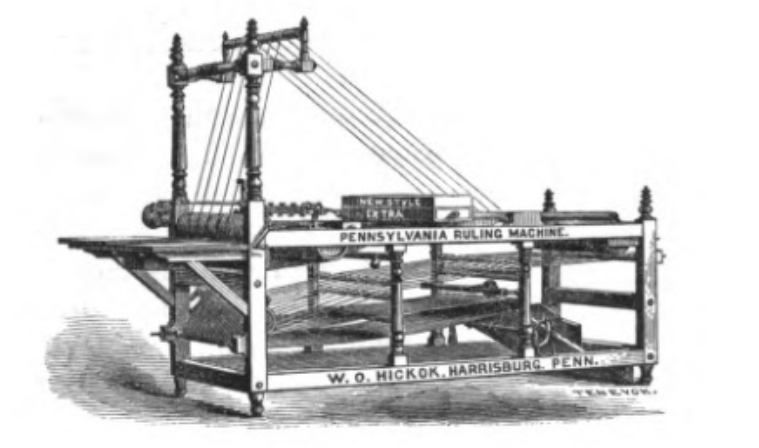
12. Illustration (1875) of a Pennsylvania ruling machine. Via Lisa Gitelman and Paper Knowledge (Duke University Press, 2014). Care of HathiTrust and the New York Public Library. Public domain.
~ Begin transitioning from media histories of paper to designing tabletop games informed by literary and media history, including your experiences with Mark and Condex Conquest (1 hour).
~ Chat briefly about -isms and texts that interest you (based, e.g., on your backgrounds, investments, and previous research) for the sake of prototyping this term.
Media histories, including those of paper computing, inform project design and development because they provide us with a sense of how we start in the middle, if you will, of technological reproduction and its material conditions. The past not only shapes the present and future but also demonstrates how novelty (see Chun) is value-laden across the arts, humanities, and sciences. Histories are usually about inventors and innovation, where the new is at once exceptional and prescriptive: a highly regulated sort of rupture. When we witness the allure of “new,” “innovation,” or “inventor” in media history as well as project design, where claims to novelty abound, we might thus inquire about the middle, or what happens before, around, and after the hype of novelty: maintenance, adaptations, hacks, workarounds, wear, tear, rot, and care (see Rosner and Ames).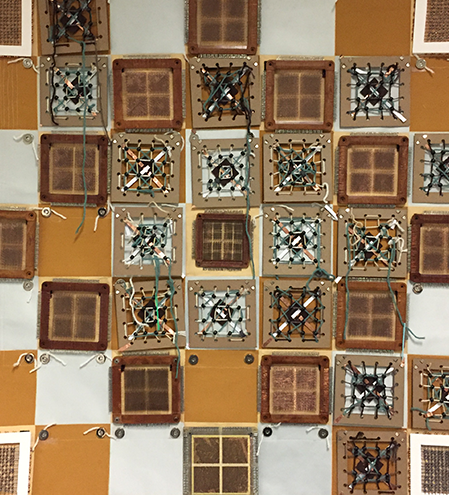
13. An electronic quilt made by Daniela Rosner, Samantha Shorey, Helen Remick, and Brock Craft that exhibits the invisible work of core memory, an early form of computer information storage woven manually by women. Project supported under NSF grant #1453329. Used with permission. And whenever we prototype something and imagine its development, we can consider how it will or should persist, where, in what conditions, and through whose labour (see Gil). Although it’s frequently ignored or unattributed, such work cannot be reduced to “service.” It’s critical, requires substantial experience, and is fundamental to knowledge production.
Week 3 (Sept. 25): Pick an -Ism and a Text. #
Week 2 engaged media histories of paper computing. This week we’ll address its literary and aesthetic elements. How do we describe the relationship between art and computation? Paper, patterns, and experimentation? Work, labour, and item? This week will also be an opportunity for you to begin your own research on a particular -ism and primary text. Both will ultimately inform the prototyping process, from Week 6 forward.Keywords and methods for Week 3: action writing, artifact analysis, artist’s book, diegetic action, interface, labour, ludology, manifesto, metadata, moveable book, narratology, nondiegetic action, protocol, work, zine
Guest speaker for Week 3: Anne Burdick (Chair, Media Design Practices, ArtCenter) on design and the humanities
Prior to seminar, please:
~ Read Mary Ann Caws, “The Poetics of the Manifesto: Nowness and Newness” (from Manifesto: A Century of Isms, 2001); Johanna Drucker, “The Artist’s Book–As Idea and Form” (from The Century of Artists’ Books, 1995); and Janice Radway, “Zines, Half-Lives, and Afterlives: On the Temporalities of Social and Political Change” (2011).
~ Survey some -isms between 1870 and 1970 (e.g., symbolism, absurdism, and futurism) and select one to study this term. You’ll need to commit to an -ism by Week 6.
~ Select a primary text (fiction, poetry, manifesto, or even a game) that represents the -ism. You will use this text for prototyping this term, and you’ll need to commit to it by Week 6. Consider working with materials in Special Collections.
~ Describe (~250 words plus images) your -ism and primary text in your design doc, including not only details about your -ism’s history, politics, and aesthetics (please be as precise as possible and avoid rehearsing information already found in reference materials) but also metadata for your selected text.Metadata: Following terms from the Dublin Core Metadata Element Set, please provide metadata for ‘coverage’ (the spatial or temporal topic of the resource), ‘creator’ (an entity primarily responsible for making the resource), ‘date’ (a point or period of time associated with an event in the lifecycle of the resource), ‘description’ (an account of the resource), ‘format’ (the file format, physical medium, or dimensions of the resource), ‘publisher’ (an entity responsible for making the resource available), ‘rights’ (information about rights held in and over the resource), ‘source’ (a related resource from which the described resource is derived), ‘subject’ (the topic of the resource), and ‘title’ (a name given to the resource).
~ Optional: play Capital Lux (science fiction, card drafting, hand management, bluffing, 2-4 players), Citadels (fantasy, city building, card drafting, variable player powers, 2-8 players), Hanabi (memory, cooperative, hand management, set collection, 2-5 players), Hive (abstract, grid, tile placement, 2 players), Secrets (party, spies, card drafting, take-that, 4-8 players), Sushi Go (drafting, hand management, set collection, simultaneous action selection, 2-5 players), or Unlock! (theme, puzzle, storytelling, cooperative, 2-6 players).
During seminar, we will:
~ Share your -isms and conduct artifact analyses of your primary texts (1 hour). Please log this work in your design doc.Work, Expression, Manifestation, Item: When conducting artifact analyses, I find distinctions between ‘work,’ ‘item,’ ‘manifestation,’ and ‘expression’ to be helpful. Works are realized through one or more expressions, which are embodied as manifestations, which are exemplified as items. For instance, content (work) may be written in English and French (expressions), published (manifestation) by a press, and circulated in batches of 5000 copies (each copy = an item). Artists’ books are interesting here because they foreground the status and labour of work as an item. See FRBR.
~ Discuss Anne Burdick’s design of Writing Machines (composed with Katherine Hayles; to be circulated during seminar) and her speculative design brief (also circulated during seminar) for Visible Language (30 minutes).
~ Consider the meaningful overlaps of, and differences between, artists’ books, moveable books, manifestos, zines, and tabletop games (30 minutes).
~ Scenario-prototype possible “contexts of use” (see Botero) for your -isms and primary texts in the present moment (1 hour). Please log this work in your design doc.
Literary histories are important to project design and development in the humanities because they demonstrate why processes of composition and publication matter for expression, experimentation, representation, and community-building. In short, they show how writing is a form of action. It is not merely interpreted; it does something. And if we treat manifestos, artists’ books, moveable books, and zines as types of “action writing” (see Marcus), which either prompts actions or contains charged design elements, then their links to tabletop games (past and present) become clear. Following Walter Benjamin,
14. Walter Benjamin, coloured symbols for cross-referencing Passagen / Baudelaire (1927-40). Care of Hamburger Stiftung zur Förderung von Wissenschaft und Kultur. Via Akademie der Künste. we might then politicize a given project’s aesthetics or assess its aestheticization of politics, including how writing acts and affords action. Prototyping something while also studying its history and composition may be one step in this approach. Understanding it as an entanglement with people and culture (and not just an object to be found, collected, or consumed) may be yet another.
Week 4 (Oct. 2): Play Some Games. #
This week we’ll focus on play and patterns of play. How is play critical? Structured? Poetic? How is it entwined with power and consent? How and where does it draw boundaries? Engaging these questions now should help us to refine the prototyping process later in the term. I’ll also ask you to play at least two tabletop games this week.Keywords and methods for Week 4: abstracts, affordances, ameritrash, analysis paralysis, area control, character development, collection, collusion, cooperation, deduction, dexterity, eurogame, escape, induction, incentive, investment, legacy, leveling, metagaming, mixed motive, negotiation, pacing, prediction, programmed movement, randomness, real-time, risk, route or network building, tableau, turns, uncertainty principle
Guest speaker for Week 4: Isaac Childres (Cephalofair Games) on designing and developing Gloomhaven
Prior to seminar, please:
~ Read Bethany Nowviskie, “Ludic Algorithms” (2014); Mary Flanagan, “Introduction to Critical Play” and “Board Games” (from Critical Play: Radical Game Design, 2009) (see also “Grow a Game” by Values at Play); and Isaac Childres’s description of Gloomhaven (2015).
~ Play at least two different categories of tabletop games with at least one other person in this seminar. You’re welcome to invite people who aren’t in the seminar, too. If you include them in your design doc, then please get their written or recorded permission.Lists, lists, lists: of game categories and mechanics; also, the journal, Analog Game Studies; the blogs, Katie’s Game Corner and Unwinnable; and some YT channels (mileage may vary), like No Pun Included, Late to the Table, Girls’ Game Shelf, Take Your Chits, Misscliks, Aloha Nerd and Geek, Wil Wheaton’s TableTop, and SUSD
~ Assess (~300 words plus images) in your design doc the play experience of one game. And only one. In this “session report,” please include details about what you played, with whom, and for how long, together with commentary on how player dynamics bridged the game’s mechanics and aesthetics.Some questions for assessment: Borrowing from Consalvo and Dutton, how is progress defined and communicated? How can players cheat or break the rules? How clear are the rules? What aspects of the game state are perceivable? What’s concealed? How does the game refer to other games and media? How do players relate through the theme, mechcanics, and components, and to what effects? What are the default settings? What’s stereotypical or generic? What’s not? Would you play the game again?
During seminar, we will:
~ Discuss Gloomhaven (to be circulated during seminar) as well as your experiences thus far playing and assessing tabletop games (1 hour).
~ Paper-prototype your -isms as grid-based games (1 hour). Please log this work in your design doc.
~ Outline some issues involved in prototyping your -isms as games via A-D-M and M-D-A frameworks (1 hour). Please log this work in your design doc.
Understanding play is important for design and development because play is a common mode of engagement for many projects.
15. H. G. Wells playing a wargame with W. Britain toy soldiers according to the rules of Little Wars (1913), which he wrote. Illustration by Samuel Begg first published in Illustrated London News (25 January 1913). Via Wikimedia Commons. Public domain. It’s one way to turn input into output, or attention into data. It produces value. In this sense, it’s labour. Consider practices such as crowdsourcing or click farming. Yet play is designed and interpreted variously, from approaches that deem it (perhaps romantically) to be either outside of work or suspended from reality (a “magic circle”), to paradigms that treat it as a lure (see McBride on “creepy treehouses”) for participation and revenue (see Bogost on “gamification” and “exploitationware”) and the entanglement of production with consumption (see Beller on the “attention economy” and Scholz on “playbor”). From a prototyping perspective, people should be able to determine their own definitions of and settings for play. Reducing play to a prescribed or unconscious activity can be a dangerous, or at least presumptuous, gesture. And for many people, play is essential to self-care and community.
Week 5 (Oct. 9): Change a Game. #
Variability is a staple in histories of paper computing. Games constantly remediate (see Bolter and Grusin) other games and media, and they are routinely remediated. Creating editions or mashups of games is a popular practice, too (e.g., Scythe becomes My Little Scythe). This week I’ll ask you to change a tabletop game while reading about variability and versioning in literary and media studies. I hope that changing a game will facilitate the prototyping process (starting next week) by rendering it less daunting or opaque.Keywords and methods for Week 5: deformance, design charrette, edition, eversion, feature or scope creep, KISS, forensic materiality, formal materiality, mashup, playtesting, provenance, remediation, tiles, versioning
Guest speaker for Week 5: Alexander Galloway (Professor, Media, Culture, and Communication, New York University) on Kriegspiel and the Debord AI
Prior to seminar, please:
~ Read Lisa Samuels and Jerome McGann, “Deformance and Interpretation” (1999); and Alexander Galloway, “Debord AI” (2018).
~ Select a tabletop game (perhaps one from last week’s session), use a lens from Schell’s deck to change it, play the change, and document the process in your design doc (feel free to use words plus images and/or video). Please bring your changed game to seminar (if this isn’t possible, then we’ll discuss alternatives).Critical play: Flanagan’s ‘reskinning’ (alter characters or objects), ‘unplaying’ (enact the unanticipated), and ‘rewriting’ (redefine play from within) may be useful, too. (See ‘Playing House’ in Critical Play.) Also see Matteo Menapace’s approach to hacking games.
Something’s due: Your design doc is due this week for assessment.
During seminar, we will:
~ Define versioning and look at some examples. Then we’ll discuss the aims of changing texts and games, prototyping the past, and interpreting works as algorithms (1 hour).
~ Playtest the games you’ve changed (1 hour).Playtesting: Here’s a great resource, by Jessica Hammer et al. Please log this work in your design doc.
~ Talk about scope and feature creep and then rapid-prototype your concept doc to prep for next week (1 hour).Feature and scope creep: Could the new idea or component stand on its own? Is it actually a new project? What exactly will it improve? Can it wait? Have you slept on it? How much more work will it produce, and for whom? How much more time will it require? What could instead be removed, revised, or changed? Please log this work in your design doc.
Changing an existing work may appear at first glance to be a flippant or frivolous gesture, but it can be quite serious. It raises questions about provenance and ethics (see Society of American Archivists, Hering et al., and Beyond Citation). It may also prompt us to reconsider popular assumptions about how, for instance, a given work was produced, interpreted, preserved, or mythologized. And if history is routinely remade and remediated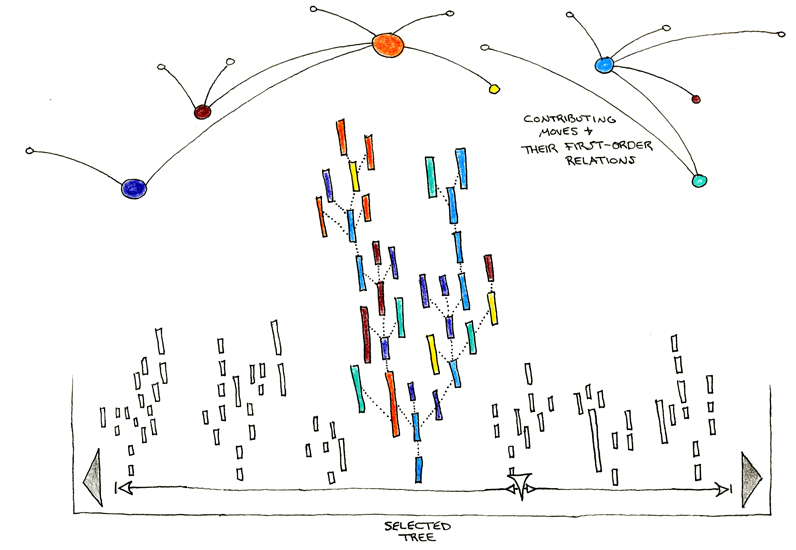
16. Sketch of the Ivanhoe game, based on Sir Walter Scott’s novel of the same name, designed by Jerome McGann, Johanna Drucker, and Bethany Nowviskie, and remediated and further developed by the Scholars’ Lab at UVa. Care of Bethany Nowviskie and the Scholars’ Lab. CC BY 3.0. Ivanhoe is also a game by Reiner Knizia. (e.g., from page to board to screen, or from paper to DOCX to HTML to PDF), then contingencies emerge everywhere along the way. Persuasive (or critical) projects not only account for the meaningful contingencies but also assume responsibility for how they interpret and what they enable when they change things (see Haraway).
Week 6 (Oct. 16): Make Your Text a Concept Doc. #
This week we’ll transition into prototyping your tabletop games. We’ll talk about the centrality of procedure and procedural literacy to design and development, and I’ll ask you to create a concept doc. As you imagine a prototype, what aspects will be fundamental to the game? What sorts of experiences will the game afford? Or avoid? What frustrations do you have with tabletop games? What do you enjoy or appreciate? How could or should literary and media history inform these decisions? And how are you using prototyping to speculate about the past?Keywords and methods for Week 6: alignment, Elito method, end or win conditions, five hat racks, flexibility trade-off, language independence, parallel prototyping, stability (refining), stickiness (SUCCES), storyboarding, swimlanes, volatility (experimentation)
Guest speaker for Week 6: Matthew Kirschenbaum (Associate Professor, English, University of Maryland) on paper computers
Please note: during the prototyping half of the term (Week 6 forward), feel free to work individually or in pairs. If you prototype in pairs, then you might need to focus on just one -ism and text for the project. If you have questions or concerns about collaborating in this seminar, then don’t hesitate to touch base with me. We can meet to further discuss possibilities and planning.
Prior to seminar, please:
~ Read Matthew Kirschenbaum, “War Stories: Board Wargames and (Vast) Procedural Narratives” (2009).
~ Draft a concept doc (~400 words plus images) for your prototype.Concepts and choices? As you consider ideas, try reading some game designer diaries or refreshing Boardgamizer a few times. Also think about your prototype in terms of player choices. How do you want your game to end? Too few choices may result in a perceived lack of control, while too many may be overwhelming. What actions will you encourage? Discourage? Reward? It should explain concisely your proposed game, identify its category and intended audience (including number of players, age minimum, and anticipated duration of play), describe briefly the theme and key mechanics (including goals, chance / randomness, and player choices), list core features in point form, and engage how you’re speculating about (or perhaps with) the history, politics, and aesthetics of your -ism and primary text.Relating with the past: Inspiration assumes various forms. It’s not always an homage. You might be annoyed by your -ism and decide to prototype its antithesis. You may want to imitate only a particular aspect. Perhaps your prototype is an impression, or maybe it’s quite literal in its methods. Just remember that you’re not making an exact reproduction here.
~ Optional: play Carcassonne (medieval, area influence, tile placement, 2-5 players), Castles of Burgundy (medieval, dice rolling, tile placement, set collection, 2-4 players), Concordia (ancient, card drafting, deck building, point-to-point movement, 2-5 players), Dominion (medieval, card drafting, deck building, hand management, 2-4 players), Galaxy Trucker (science fiction, partnership, tile placement, 2-4 players), Kingdomino (medieval, territory building, tile placement, 2-4 players), Lost Cities (exploration, hand management, set collection, 2 players), Pandemic (medical, cooperative, point-to-point movement, hand management, variable player powers, 2-4 players), Patchwork (abstract, time track, tile placement, 2 players), or Power Grid (economic, bidding, network building, 2-6 players).Endings: Games end with empty hands, group or individual achievements, set collections, area control, arrival at a destination, the expiry of time, the end of a story, player elimination, a score, the conclusion of a scenario or level . . . Which endings do you prefer? Avoid?
I’ll return feedback on seminar participation and your design docs this week.
During seminar, we will:
~ Workshop your concept docs (1 hour). We’ll focus mainly on core ideas and feasibility (what’s doable in a term). Please log this work in your design doc.
~ Discuss the roles of both procedural literacy and player choice in prototyping and how to make game states not only accessible but also reflexive (1 hour).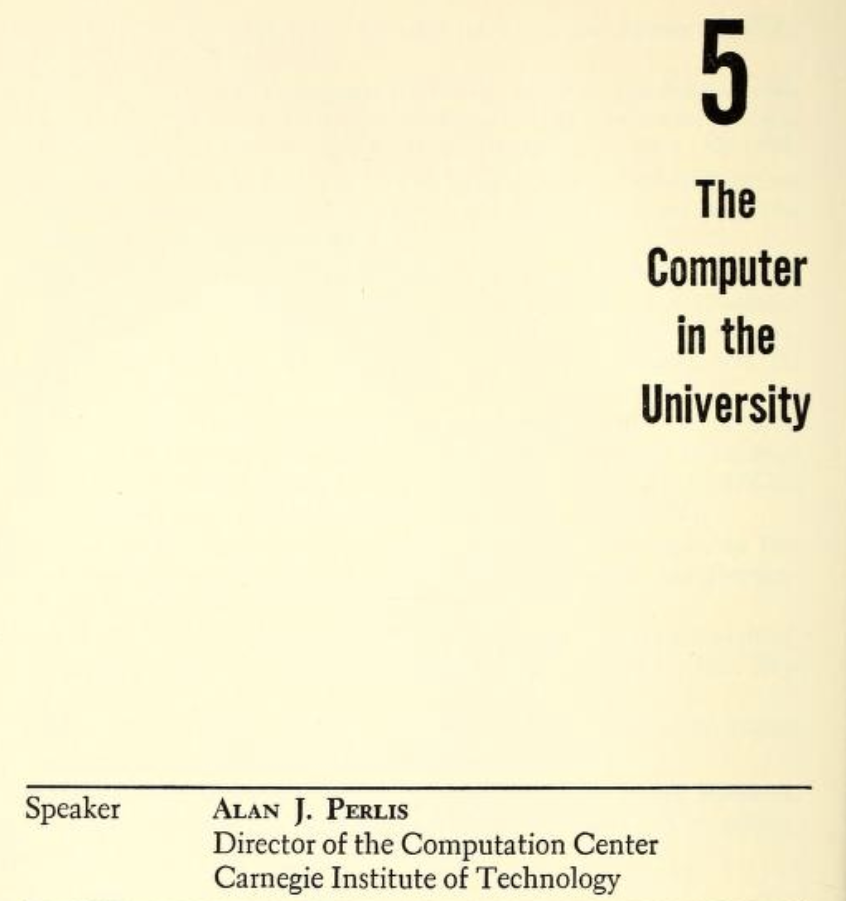
17. ‘The Computer in the University’ (1961), by A.J. Perlis, one of the first publications to engage computing and procedural literacy. Chapter 5 of Management and the Computer of the Future, Greenberg, ed. (MIT Press and Wiley & Sons, 1962). Via Michael Mateas. Care of The Internet Archive and the University of Florida. Out of copyright.
~ Rapid-prototype rules and mechanics for your -isms and texts (30 minutes). Please log this work in your design doc.
~ Rapid-prototype categories and themes for your -isms and texts (30 minutes). Please log this work in your design doc.
Procedural literacy is useful for project design and development because it encourages practitioners to think about workflow, sequence, and how people experience rules, steps, levels, mechanics, and the like. It corresponds a bit with scholarship on programming (see Vee and Mateas), mediated storytelling and expression (see Salter and Wardrip-Fruin), and black boxing (see Latour), and it facilitates the articulation of concepts with design and materials. Thinking procedurally does not preclude creativity or experimentation, either. And as demonstrated by scholarship on algorithms (see Aneesh, Crawford, and Noble), it’s certainly not free from bias. In the context of tabletop prototyping, procedures can be tested and rehearsed like recipes or scripts. You don’t need to (and probably shouldn’t) produce a polished game before testing its procedures. Here, one challenge is how to prevent procedures from determining player agency or eclipsing experience. Another is how to avoid fetishizing constraints (see OuLiPo).
Week 7 (Oct. 23): Make It a Theme or Mechanic. #
The next two weeks are opportunities for you to experiment with themes and mechanics. The ideas in your concept doc will inevitably change during prototyping, and we’ll spend some time testing prototypes and learning more about 2D and 3D design in a tabletop context. How do these design practices shape our interpretations of history? Our conjectures? Our relations with materials in collections and archives? When and why are thinking/doing and theory/practice binaries problematic?Keywords and methods for Week 7: auction, bidding, bluffing, drafting, engine or deck building, entry points, melding, multi-use cards, nudging, pickup and deliver, points salad, shedding, signaling, trading, trashing, twitching, worker placement
Guest speakers for Week 7: Derek Hansen (Associate Professor, School of Technology, Brigham Young University) and Kari Kraus (Associate Professor, College of Information Studies, University of Maryland) on designing The Tessera Inventors
Prior to seminar, please:
~ Read Samuel R. Delany, “The Necessity of Tomorrows” (1978/1984); and Elizabeth W. Bruss, “The Games of Literature and Some Literary Games” (1977).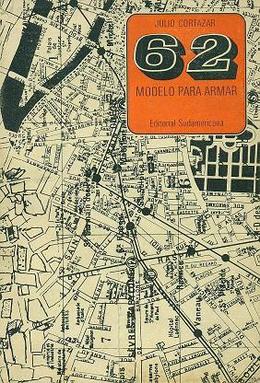
18. 62: A Model Kit (Modelo para armar), by Julio Cortázar (1968), where each reader constructs a personal montage. Via Elizabeth Bruss. Care of Wikimedia. Low resolution illustration. Fair dealing.
~ Paper-prototype and document (in your design doc) the theme or mechanics of your proposed tabletop game.Game lab: Tho it can be somewhat overwhelming, the Board Game Design Lab points to various resources for themes and mechanics. If you’re starting with the theme, then consider addressing the subject matter, genre(s), setting(s), roles, and conflict(s) at play in your game, primary text, and -ism. If you’re starting with mechanics, then consider the core actions or “verbs” that the game and players will perform, and how they align (or not) with your -ism and primary text. In either case, reviewing lists of themes and mechanics may facilitate the process. Also feel free to parallel prototype (experiment with multiple designs at once). Doing so may help you to be more precise about how exactly the dynamics of your tabletop game will bridge aesthetics with mechanics. Where possible, note in your design doc how and why aspects of your concept doc are changing during prototyping. And please bring your prototype(s) to seminar.
~ Optional: play Azul (abstract, renaissance, tile placement, set collection, pattern building, 2-4 players), Betrayal at House on the Hill (horror, cooperative modular board, partnerships, 3-6 players), Cosmic Encounter (science fiction, bidding, take-that, simultaneous action selection, variable player powers, 3-5 players), Flamme Rouge (racing, hand management, modular board, simultaneous action selection, 2-4 players), Magic Maze (real-time, cooperative, grid movement, variable player powers, 1-8 players), Onirim (fantasy, cooperative, hand management, set collection, 1 or 2 players), Mint Works (economic, worker placement, card drafting, 1-4 players), Race for the Galaxy (science fiction, hand management, simultaneous action selection, variable player powers, 2-4 players), Sagrada (dice, set collection, pattern building, 1-4 players), or Witness (comics, mystery, cooperative, storytelling, 4 players).
During seminar, we will:
~ Playtest your themes and mechanics (1 hour).One problem: When asking people to playtest your prototypes, it may help to articulate a specific problem for them to focus on. You can even ask them to propose possible solutions, which you can then test and discuss. Also try observing and documenting the playtest without intervening to clarify, explain, assist, and whatnot. Please log this work in your design doc.
~ Further discuss how both science fiction and speculative design inform game prototyping (30 minutes). Alongside Delany and Bruss, we’ll consider the following examples: The Tessera Inventors (Hansen, Kraus, et al.) and “Ada’s Poetical Science” (Kraus).
~ Visit the Library for a workshop on 2D design (1.5 hours).Symbols: Libraries of symbols and other images are helpful when prototyping with software such as Adobe CC. For instance, see Fractal Thought and the Noun Project. This design work factors into the ‘language independence’ of games.
Design histories: Let me know if you’re looking for histories of design practices. Drucker and McVarish’s Graphic Design History: A Critical Guide is an excellent starting point.
The tensions between themes and mechanics persist across projects, and they are comparable to narratology/ludology debates in academia. Of course, themes and mechanics mutually inform each other, and people’s preferences (and biases) for them vary. Knowing a bit about each can be useful for project design (see Costikyan). After all, both are processes entwined with not only ethics (see Sicart) but also the histories of speculation (see Haraway and Ada), an aesthetic and political practice which is often dehistoricized for the sake of object-oriented allure (e.g., a “thing” we don’t recognize) or eschatological fantasies (e.g., “end of man” tales).
Week 8 (Oct. 30): Make It a Mechanic or Theme. #
Building on Week 7, we’ll continue prototyping themes and mechanics, but with more attention to how power unfolds in and through games. What are the default settings of most tabletop games? How do conflicts, problems, and partnerships unfold? Who is represented, how, by whom, and under what assumptions? How are mechanics biased, and to what effects on play experiences and play communities? How do games rehearse as well as resist colonialism, capital accumulation, worker exploitation, white supremacy, and cis heteropatriarchy in their themes and mechanics? What are some intersectional approaches (see Crenshaw) to project design and development?Keywords and methods for Week 8: 80/20 rule, accumulation, actual play, asymmetry, balance, default settings, elimination, hidden identity, quarterbacking, secret identity, turtling, world design, variable player order
Guest speaker for Week 8: Avery Alder (game designer) on designing and publishing The Quiet Year and Monsterhearts
Prior to seminar, please:
~ Play Avery Alder’s The Quiet Year.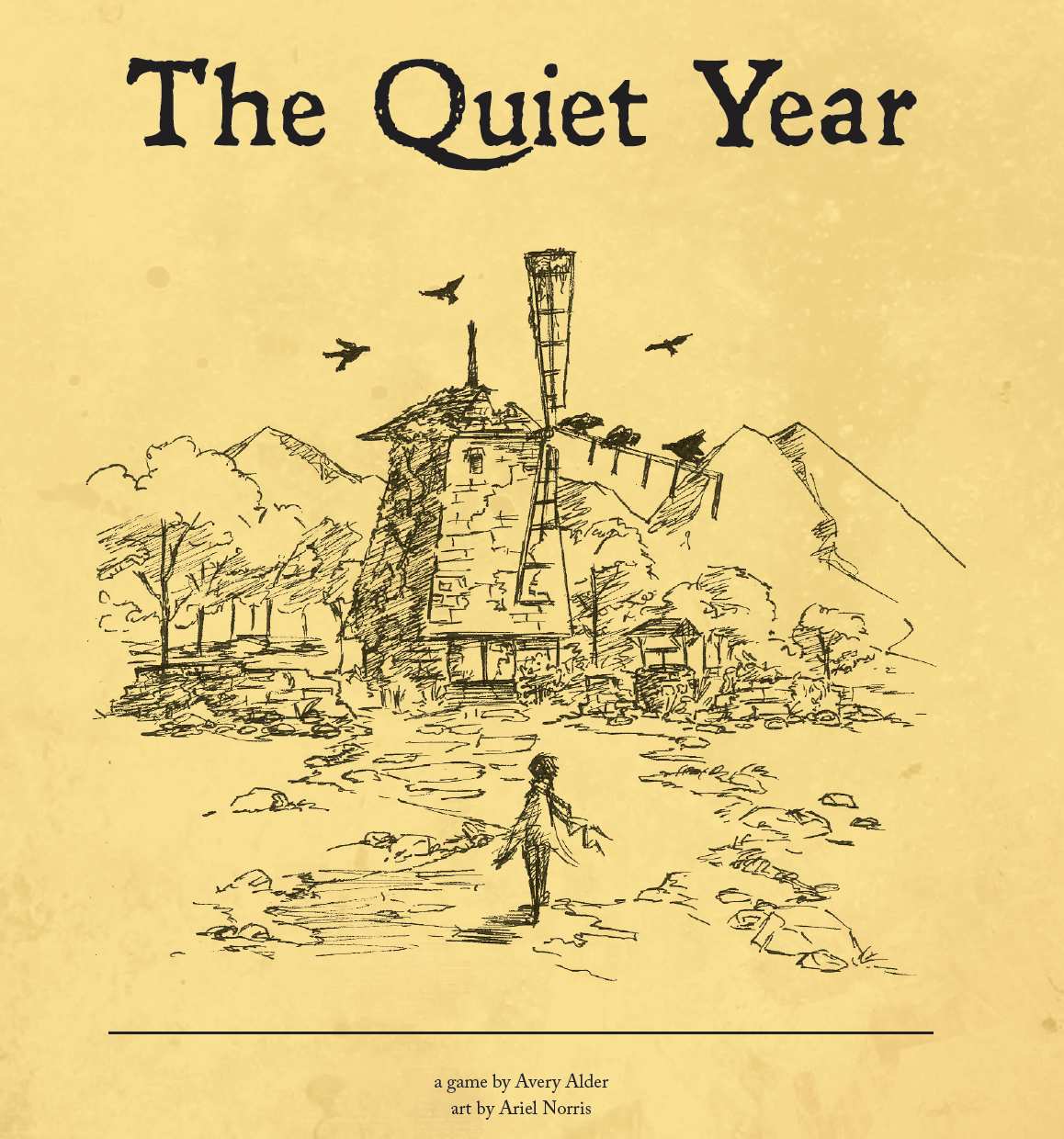
19. The Quiet Year, a game by Avery Alder. Art by Ariel Norris. Formats: print and PDF. Used with permission. Feel free to document actual play sessions in your design doc.
~ Read Elizabeth LaPensée, “Indigenous Board Game Design in The Gift of Food” (2016); listen to the N.D.N. Players podcast (especially Episode 5, “Sovereignty in Gaming”); and review Decolonizing Practices (founded by Michelle Lorna Nahanee) and the OMG project.
~ Paper-prototype and document (in your design doc) the theme or mechanics of your proposed tabletop game. If you’re starting with the theme, then consider addressing the subject matter, genre(s), setting(s), roles, and conflict(s) at play in your game, primary text, and -ism. If you’re starting with mechanics, then consider the core actions or “verbs” that the game and players will perform, and how they align (or not) with your -ism and primary text. In either case, reviewing lists of themes and mechanics may facilitate the process. Also feel free to parallel prototype (experiment with multiple designs at once). Doing so may help you to be more precise about how exactly the dynamics of your tabletop game will bridge aesthetics with mechanics. Where possible, note in your design doc how and why aspects of your concept doc are changing during prototyping. And please bring your prototype(s) to seminar.
During seminar, we will:
~ Playtest your themes and mechanics (1 hour).Symmetry: This week may be a good time to consider symmetry in your game and its relation to balance, fairness, power, and equity. During this workshop, we’ll talk about variable player powers, ‘runaway leaders,’ ‘quarterbacking,’ ‘turtling,’ and emergent, inherent, balanced, and unbalanced asymmetry. See also Jonathan Rey Lee on Catan. What symmetries and asymmetries does your project warrant? Please log this work in your design doc.
~ Discuss The Quiet Year, the social and cultural dimensions of mechanics and themes, and matters of self-determination and power in tabletop games (1 hour).
~ Visit the Library for a workshop on 3D design (1 hour).3D models: Find some on Shapeways and Thingiverse.
~ Rapid-prototype some game components to prep for next week (5 minutes).
Values are a key part of project design and development (see Flanagan and Nissenbaum). If media such as tabletop games are dominated by normative or oppressive values, then how can creative and critical practices change them? Such change involves, but is not limited to, representation (how or whether people see both themselves and history in games), dynamics (the experiences games produce through themes and mechanics), community (how groups form around games), production (who is involved in design and development processes, from ideation to publication), and labour (how and where games are made and circulated, and through what means; also, how people are compensated for their work). Here, a key text is Anna Anthropy’s Rise of the Videogame Zinesters.Zines: a collection by Anna Anthropy
Week 9 (Nov. 6): Make It an Inventory. #
This week we’ll shift to the components and economies of your prototypes.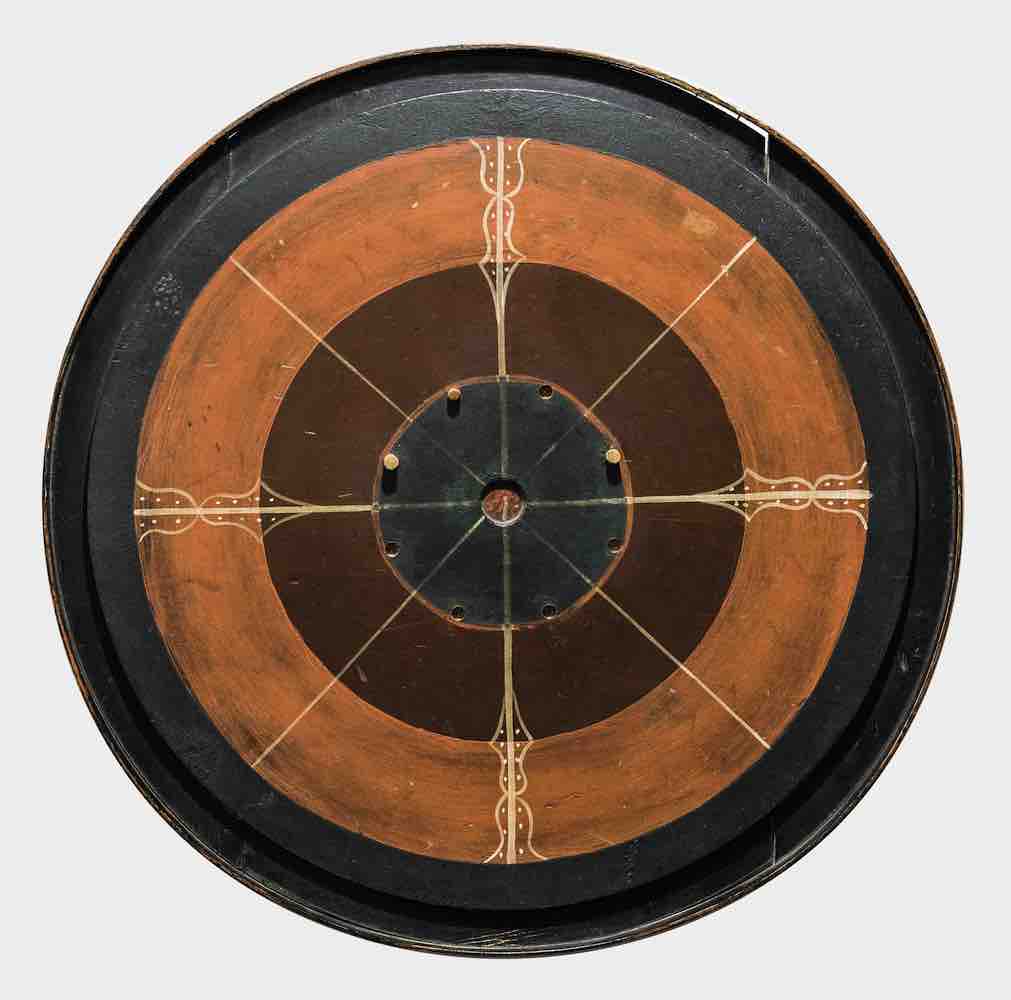
20. Wood crokinole gameboard (1875) by Eckhardt Wettlaufer of Sepastopol, Perth County. Care of Schneider Haus National Historic Site, Kitchener, Ontario. Used with permission. Here is where those bit boxes will be useful, if they have not been already. We’ll also consider the relation between the materiality of your primary texts and the design of your components, including how people interact with them. How accessible are tabletop games? What are some histories of accessibility (see Hamraie and Hendren)? What do specific materials connote, and for whom? How do game components correspond with histories of art and the everyday? How do we think about component design and social responsibility together?Keywords and methods for Week 9: chasing, chits, common fate, content audit, feature list, Fitts’ law, Hick’s law, icons, legibility, progressive disclosure, serial position effect, structural forms (frames, masses, shells), time tracks, uniform connectedness
Guest speaker for Week 9: Whitney ‘Strix’ Beltrán (E-Line Media) on design and game settings
Prior to seminar, please:
~ Read Whitney “Strix” Beltrán, “Why Minority Settings in RPGs Matter” (2015); and Patrick Rael’s “Seriously – Boardgames? Yes, Seriously” (2015).
~ In conversation with the materiality of your -ism and primary text, prototype the inventory of your game. Think about its economy but also its components: tokens, miniatures, meeples, tiles, cards, boards, grids, tracks, screens, and dice, for instance.Materials: If possible, focus on a playable prototype for now and save the particulars of production for later. You can use readily available materials instead of making your own. And then, later in the term, you can customize and refine things.
Simulator: If you’d rather prototype your inventory in Tabletop Simulator, then feel free. You can produce tactile components later in the term. Document the prototype and write briefly (~250 words) about its interface and the social, affective, and economic relations it affords. Where possible, note in your design doc how and why aspects of your concept doc are changing during prototyping.
~ Optional: play Catacombs (fantasy, dexterity, role-playing, partnerships, 2-5 players), Ex Libris (fantasy, card drafting, set collection, worker placement, 1-4 players), Fury of Dracula (horror, secret unit development, variable player powers, point-to-point movement, 2-5 players), Modern Art (economic, bidding, commodity speculation, hand management, 3-5 players), Mysterium (mystery, cooperative, hand management, pattern recognition, 2-7 players), One-Deck Dungeon (fantasy, cooperative, deck building, 1-2 players), or Root (animals, fantasy, area movement, variable player powers, 2-4 players).
During seminar, we will:
~ Playtest your inventories (1.5 hours). Please log this work in your design doc.Testing inventories: Some questions that might be useful for this week’s playtesting are, How do the materials imply a logic or sequence? How do they suggest or convey rules and progress? What actions do they trigger? How does their use depend on language? On history? On memory or cultural assumptions? How are players asked to carry materials? How heavy is the game? What’s discarded and where during play? How are the components conducive to silence, politicking, role-playing, or analysis paralysis? How do they correspond with probability? Also try substituting components with other types of components. This exercise may facilitate accessibility.
~ Discuss the relationship between inventories, game settings, cultural assumptions, and player experiences (1 hour).
~ Begin planning the end-of-term event (30 minutes).
The components of a project produce and reinforce experiences, and tactile media have interfaces, too (see Emerson). Of course materials matter; however, they are often taken for granted as simple byproducts of games (merely tactile manifestations of ideas). At the same time, divisions of labour make it difficult for people to contribute to how projects are designed or manufactured. Familiarity with the entire process is rare, and participating in every step (or seizing the means) can be resource-intensive and exhausting, one reason why many DIY projects struggle to persist. Critical design (see Bardzell and Bardzell), including issues of speculation, social responsibility, and accessibility, requires community, and ideally culture (not a tool or gadget) comes first.
Week 10 (Nov. 13): Take a Break from It. #
Take a break from research, writing, and prototyping. Overwork is toxic, and self-care is important to thriving.
If playing games doesn’t feel like work, then below are some games that have not yet appeared on the schedule. Some are rather involved, tho. Hmmm… so maybe they are work? Your call. I wish you a restful and relaxing break.
21. ‘Kaninchen und Ente’ (‘Rabbit and Duck’) from the 23 October 1892 issue of Fliegende Blätter. It’s a language-game of aspects according to Ludwig Wittgenstein (Philosophical Investigations, 1953), who made the rabbit-duck famous. Care of Wikimedia. Public domain.
Optional: play Agricola (animals, farming, area enclosure, worker placement, 1-5 players), Consulting Detective (mystery, secret agent, cooperative, storytelling, 1-8 players), Dead of Winter (horror, cooperative, action point allowance, storytelling, bluffing, 2-5 players), Dog Eat Dog (“a game of imperialism and assimilation on the Pacific Islands,” at least 3 players), El Grande (renaissance, area influence, bidding, simultaneous action selection, 2-5 players), Fog of Love (bluffing, role-playing, hand management, storytelling, simulation, 2 players), Inis (ancient, area influence, modular board, tile placement, 2-4 players), Isle of Skye (economic, bidding, set collection, tile placement, 2-5 players), Memoir ‘44 (wargame, grid movement, area influence, campaign, 2-8 players), Pandemic Legacy (like regular Pandemic, but better), Scythe (science fiction, area influence, variable player powers, 1-5 players), Space Cadets (science fiction, dexterity, real-time cooperative, 3-6 player), Sheriff of Nottingham (bluffing, humour, role-playing, hand management, 3-5 players), Spirit Island (fantasy, cooperative, modular board, variable player powers, 1-4 players), Steam (trains, bidding, network building, tile placement, 3-5 players), Stone Age (prehistoric, set collection, worker placement, 2-4 players), Suburbia (city building, economic, set collection, tile placement, 1-4 players), Terra Mystica (fantasy, economic, area influence, network building, 2-5 players), Terraforming Mars (science fiction, economic, tile placement, set collection, 1-5 players), Troyes (medieval, area influence, dice, worker placement, 2-4 players), or Twilight Imperium (600 minutes, 3-6 players).
Week 11 (Nov. 20): Fabricate It. #
Although you’re not producing a polished game for this course, we’ll spend this week talking about fabrication. How do computer numerical control (CNC) machines, such as laser cutters, routers, and 3D printers, shape our interpretations of history? What are their roles in speculative design, or in conjecturing with and through materials? How are they more than copy machines? We’ll also talk generally about methods for prototyping the past in media and literary studies.Keywords and methods for Week 11: CNC, desire lines, fabrication, laser-cutting, love and breakup letters, Ockham’s razor, routing
Guest speaker for Week 11: Renee M. Shelby (PhD candidate, School of History and Sociology, Georgia Institute of Technology) on prototyping Suffragetto
Prior to seminar, please:
~ Read Margaret Konkol, “Prototyping Mina Loy’s Alphabet” (2018); and Nicole Clouston and me, “Fabrication and Research-Creation in the Arts and Humanities” (2016).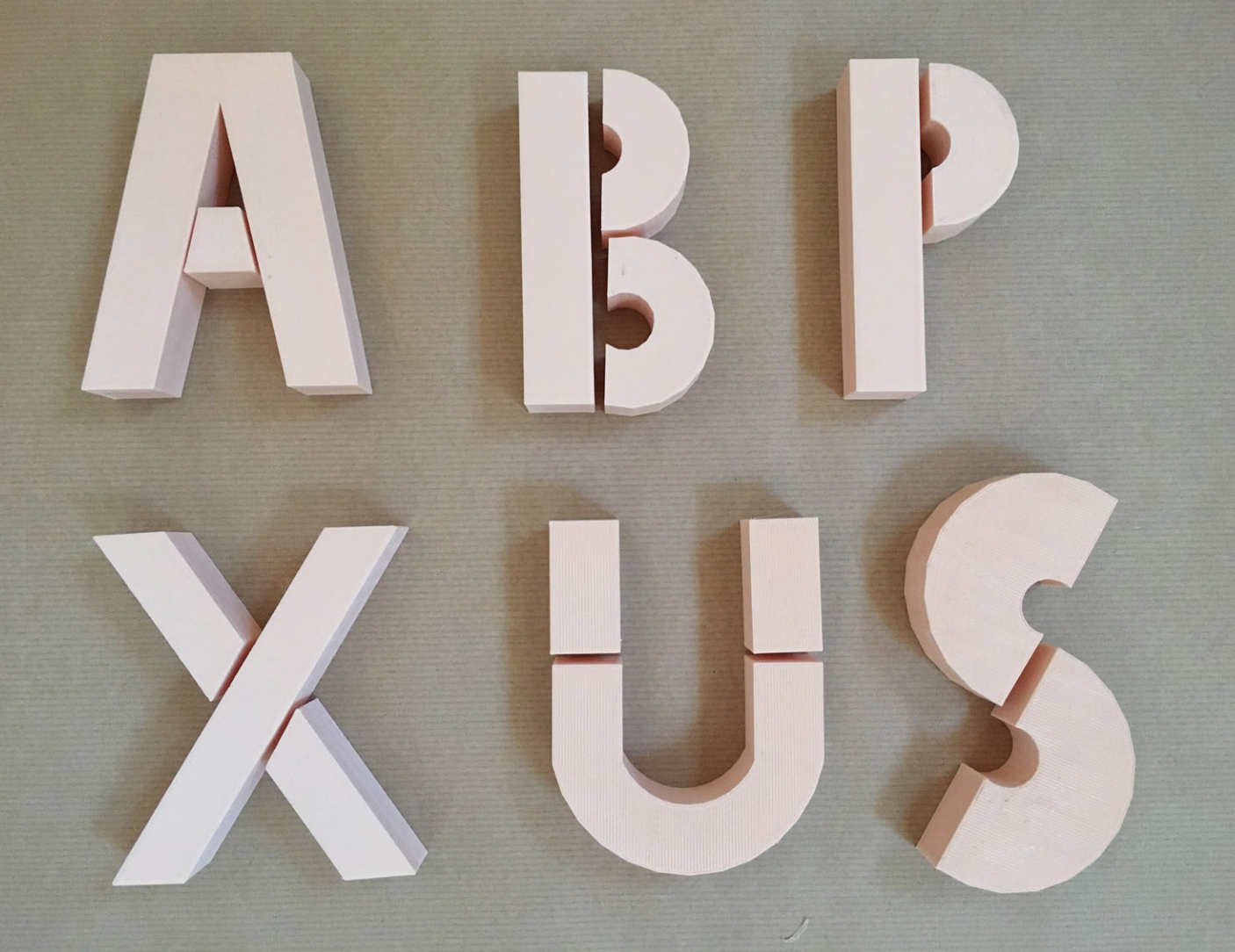
22. Margaret Konkol’s prototype of Mina Loy’s ‘The Alphabet that Builds Itself.’ PLA. Designed and printed in 3D. Care of Konkol and Feminist Modernist Studies. Used with permission.
~ Refine your prototype if you wish and log the changes in your design doc. Please bring your prototype(s) to seminar.
During seminar, we will:
~ Continue playtesting your prototypes. We’ll experiment with shifting balances, clarity of outcomes, and degrees of probability and predictability in your games and also determine what graphics and other components they may need (1 hour). Please log this work in your design doc.
~ Discuss fabrication methods, their research applications, and their intersections with speculative design and paper computing (30 minutes).Automated or manual? If you’re unsure how to approach the production of your prototype, let’s talk. Some people prefer manual approaches. Then you can photograph the results. But printing and laser-cutting can be more precise, and perhaps friendlier to people who work with software.
~ Prep for next week by talking about how to write and test rules for a manual (30 minutes). I’ll bring a variety of examples to peruse.
~ Visit the Library for a workshop on fabrication (1 hour).
There’s a lot of hype around fabrication, especially 3D printing. Learning more about it helps to demystify popular depictions and determine what, if any, applications exist for creative and critical work. Fabrication also prompts people to engage the past with (the limits of) perspective and 2D expression in mind. After all, histories of media are also histories of the senses (see Crary, Douglas, and Sterne).
Week 12 (Nov. 27): Make It a Manual. #
Rules. This week we’ll focus on how to communicate them, test them, clarify them, test them again, refine them, test them once more, and further refine. We’ll look at examples of game manuals (some compelling, some perplexing), and we’ll consider various styles and approaches to their composition. How are they like artists’ books and zines? How are they absolutely not? We’ll also workshop how to write materials for both paper and screen.Keywords and methods for Week 12: cognitive walkthrough, efficiency, flow, fly-on-the-wall, inverted pyramid, kibitzing, kingmaking, performance load, personas, rules lawyer, think-aloud protocol, Zeigarnik effect
Guest speaker for Week 12: Nikki Valens (freelance game designer) on designing, writing, and editing Mansions of Madness
Prior to seminar, please:
~ Read Jessica Hammer and Meguey Baker, “Problematizing Power Fantasy” (2014).
~ Draft your manual, which should include a hook, components list, and descriptions of structure, setup, regular play, exceptions, and end of game. It should also mention minimum age, average play duration, and number of players. Consider a combination of images with text as well as consistent terms and visuals throughout the manual. Feel free to compose the manual by hand, with software, or through a combination of techniques. Please bring your draft manual to seminar.
~ Gather all your prototyping files on your computer and place them in a single folder, which will become a repository for your project.
~ Refine your prototype if you wish and log the changes in your design doc. Please bring your prototype(s) to seminar.
During seminar, we will:
~ Discuss Mansions of Madness (Second Edition) (to be circulated during seminar), including its theme, mechanics, and design across board and app (1 hour).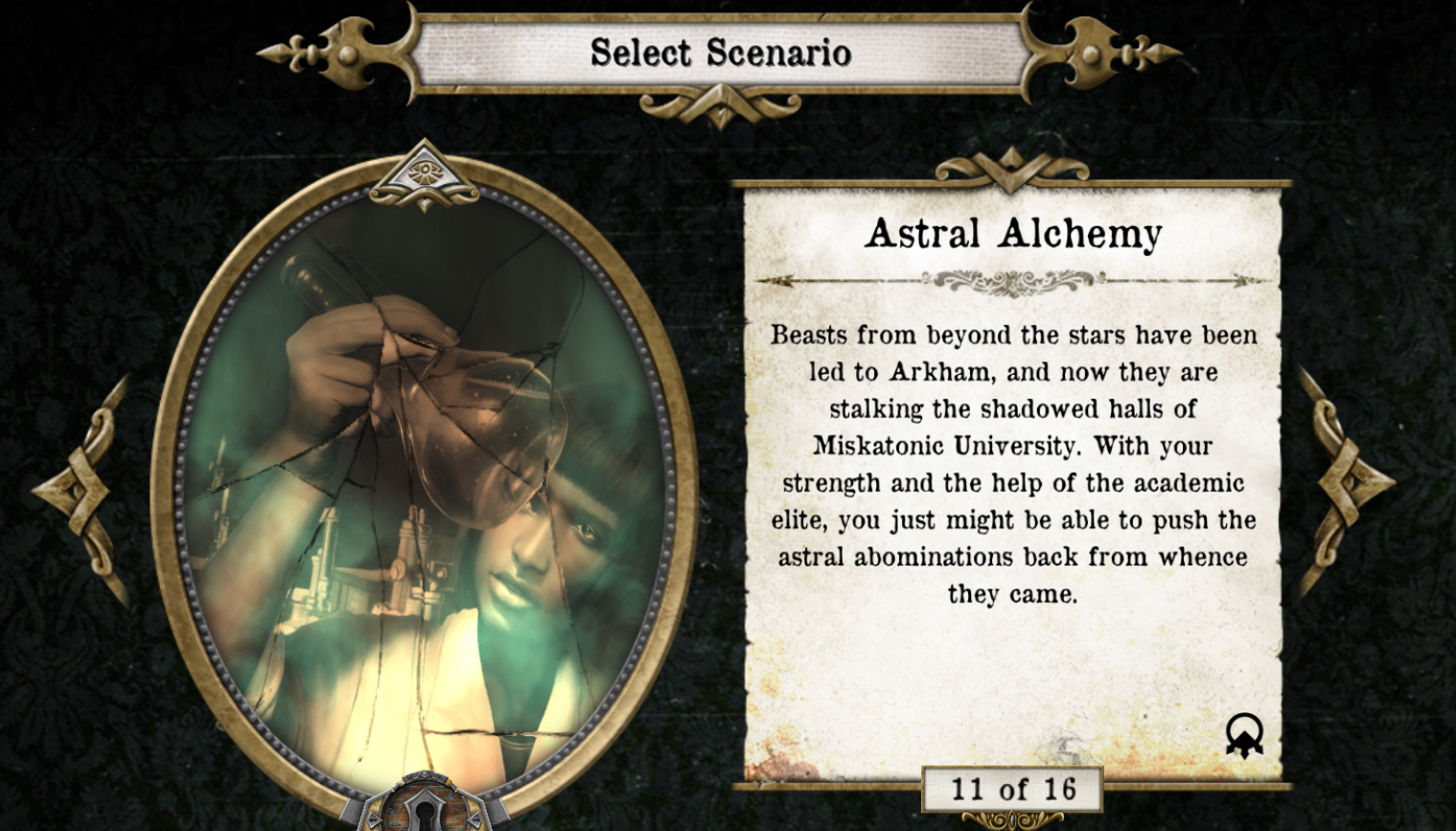
23. Screengrab of the app for Mansions of Madness (Second Edition), designed by Nikki Valens. Care of Valens and Fantasy Flight Games. Used with permission.
~ Playtest your rules (1 hour). This will include tests for cheating or bending the rules as well as exercises where you remove rules. Please log this work in your design doc.
~ Structure your prototypes as repositorites of files and then review approaches for circulating them online.The Internets: For storage and circulation, we’ll probably look at GitHub and Itch. We will also discuss how access relates to these approaches (1 hour).
~ Finalize the details for the end-of-term event.
Manual design is a space where the humanities have much to contribute. Most people begin their tabletop games with manuals, the layout and content of which can be off-putting, confusing, elliptical, repetitive, or dry. But some manuals are quite clever, fun, and even experimental, usually when they demonstrate knowledge of how writing and design are entwined (see Arola and Ball).
Week 13 (Dec. 4): Refine and Package It. #
If we have time this week, we’ll discuss various takes on the scales of tabletop gaming, which intersects frequently with the design, collection, and painting of miniatures. Are these worlds escapist? How do they treat time, and how do people experience time in them? What do people want from them, and what are their material histories? Of course, at this point in the term, you’ll probably need a chunk of seminar to refine your prototype. We’ll talk about the refining and publishing process, and we’ll also bind your game manuals with some help from UVic Libraries.Keywords and methods for Week 13: elaborative rehearsal, Kano analysis, maintenance rehearsal
Guest speakers for Week 13: Emily Care Boss (Black and Green Games) on designing, developing, and publishing games; and also Michael Lines (Learning and Research Librarian, UVic) on bookbinding
Prior to seminar, please:
~ Read Susan Stewart, “The Miniature” (from On Longing: Narratives of the Miniature, the Gigantic, the Souvenir, the Collection, 1993); and Louise Krasniewicz, “Miniature Manifesto” (2015).
~ Refine and polish your prototype, including the manual. Document the changes. Please bring your (final?) prototype to seminar, together with at least two print copies of your (final?) manual.
Something’s due: Your design doc is due this week for assessment.
During seminar, we will:
~ Discuss Black and Green Games (materials to be circulated during seminar), including their approach to publishing and design (1 hour).
24. Romance Trilogy, three quick games about the human heart, by Emily Care Boss. Care of Black and Green Games. Used with permission.
~ Playtest your prototypes one more time, with an emphasis on lingering issues and concerns as well as packaging (30 minutes). Please log this work in your design doc.
~ Bind your manuals during a bookbinding workshop (1 hour).Bookbinding: You’ll have the option to bind your manual with quality paper covers. I’ll provide you with some paper types to select, and Michael Lines will supply needles and thread for the day. He’s suggested a pamphlet binding with options for pockets in the covers, or wrap-around closures.
~ Review what we’ve done and learned and then complete course experience surveys (30 minutes).
A lot of labour goes into prototyping a project. And for the purposes of research and experimentation, prototypes may stand on their own. (To be candid, this is my preference and approach.) Yet there’s even more to do once prototyping is done. Development, testing, production, binding, packaging, rights management, licensing, publication, distribution, expansion, and archiving are demanding and complex processes, hence the tendency for gaming and other media practices to be both collaborative and distributed in character.
Week 14 (Dec. 11): Share It. #
Congratulations! You’re almost there, and it’s almost done!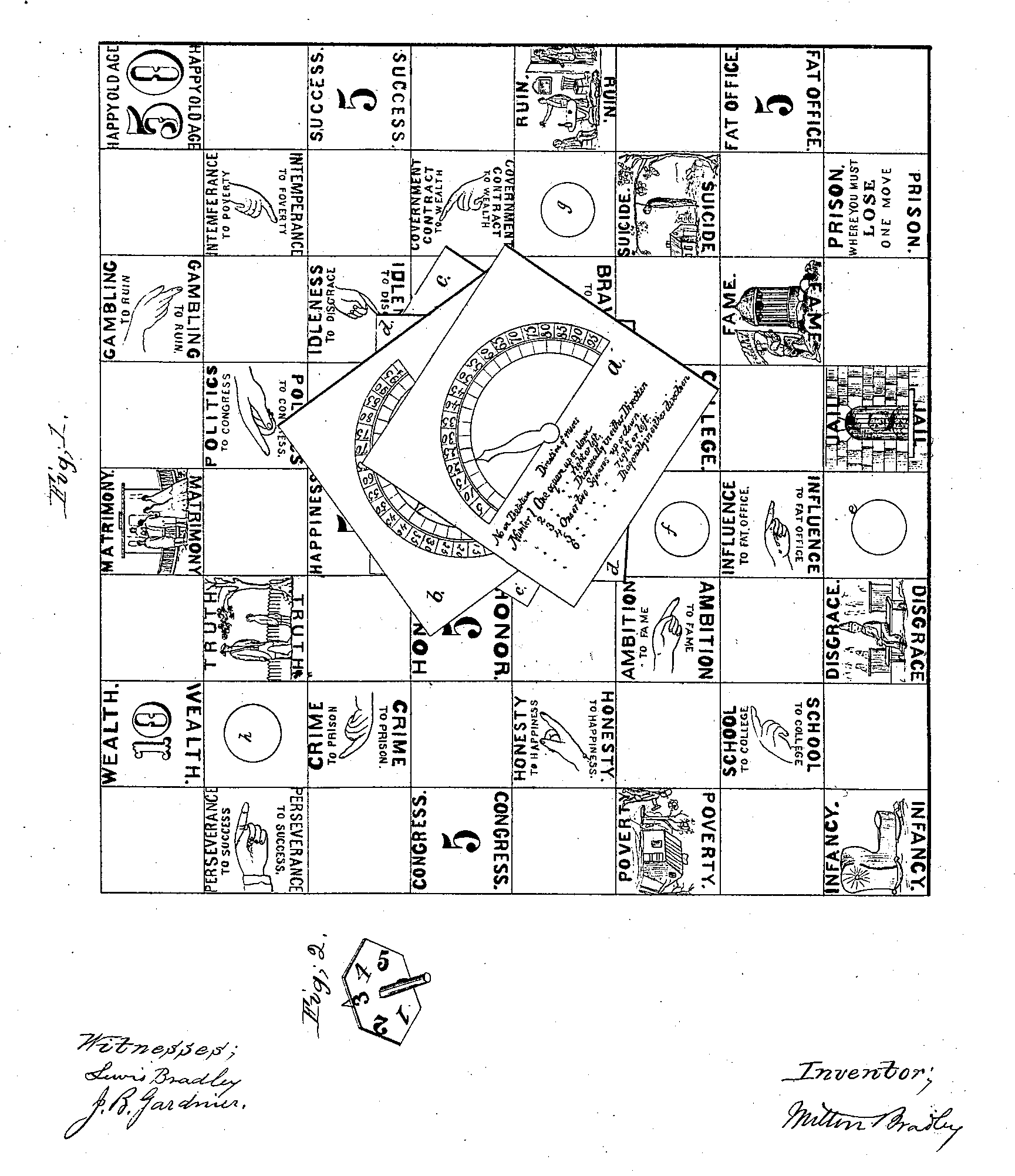
25. Milton Bradley’s US Patent 53561A (1866) for Social Game. ‘The game, as here arranged, is called the checkered game of life, and, in addition to the amusement and excitement of the game, it is intended to forcibly impress upon the minds of youth the great moral principles of virtue and vice.’ Care of Google Patents. Public domain. This week (exact date and time to be determined, and subject to group approval), you’ll present your prototype and ask people to play it. After that, I’ll give you some time to revise your presentation into a short paper, which you can submit with your prototype.
During the end-of-term event, please:
~ Present your prototype, its relation to your -ism and primary text, and its relevance to literary and media studies (5-7 minutes). Don’t forget to also engage how exactly your prototype speculates about the past.
~ Invite people to play the prototype, which should be accompanied by your manual (packaging optional).
~ Observe and, if you wish, document (with permission) how people play your prototype.
I’ll return feedback on, as well as marks for, seminar participation and your design docs before the end-of-term event. After the event, I’ll also provide you with feedback on your prototype and talk before they’re due for assessment.
After the event (no later than December 18th at noon), please:
~ Submit your prototype as a tactile thing and repository of files. The prototype should include your manual and all game components.
~ Email me your talk in polished form (as a paper of 1500-2000 words, plus figures, notes, and works cited in MLA format).
Thanks a bunch for taking this seminar!
All the best,
Jentery